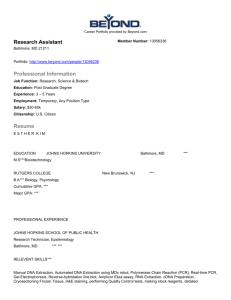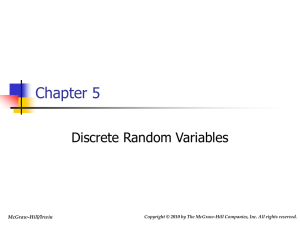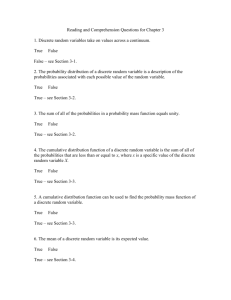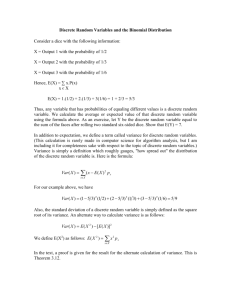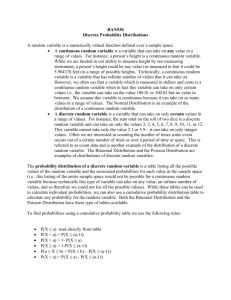Discrete Probability Distributions
advertisement
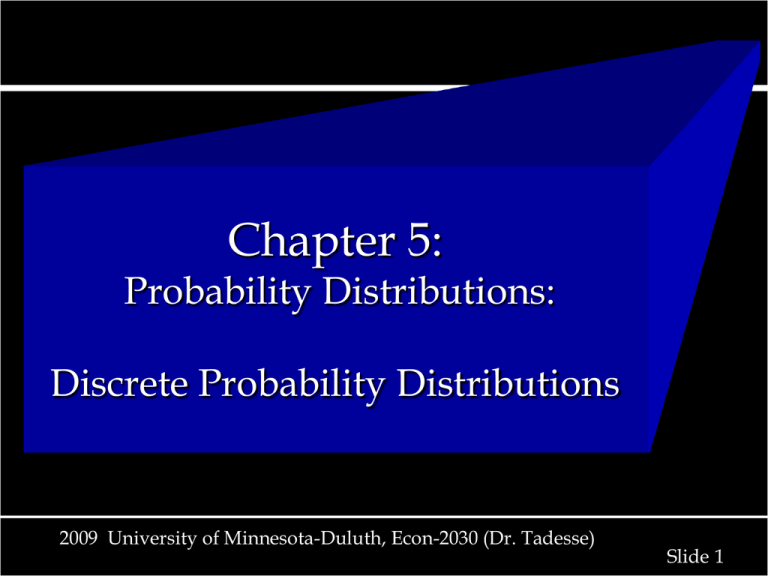
Chapter 5: Probability Distributions: Discrete Probability Distributions 2009 University of Minnesota-Duluth, Econ-2030 (Dr. Tadesse) Slide 1 Learning Objectives Identifying Types of Discrete Probability Distribution and their Respective Functional Representations Calculating the Mean and Variance of a Discrete Random Variable with Each of the Different Discrete Probability Distribution. 2009 University of Minnesota-Duluth, Econ-2030 (Dr. Tadesse) Slide 2 Random Variable 2009 University of Minnesota-Duluth, Econ-2030 (Dr. Tadesse) Slide 3 Random Variables Any variable that is used to represent the outcomes any experiment of interest to us is called Random Variable. A random variable can assume (take) any value (Positive, negative, zero; finite, infinite; continuous and discrete values). Depending upon the values they take, we can identify two types of random variables: 1. Discrete Variables 2. Continuous Variables. 2009 University of Minnesota-Duluth, Econ-2030 (Dr. Tadesse) Slide 4 Both types of variables can assume either a finite number of values or an infinite sequence of values. 2009 University of Minnesota-Duluth, Econ-2030 (Dr. Tadesse) Slide 5 Example: JSL Appliances Discrete random variable with a finite number of values Let x = number of TVs sold at a given store in one day. The number of TV units that can be sold in a given day is finite. It is also discrete: (0, 1, 2, 3, 4). X can be considered as Discrete Random Variable 2009 University of Minnesota-Duluth, Econ-2030 (Dr. Tadesse) Slide 6 Example: JSL Appliances Discrete random variable with an infinite sequence of values Let Y = number of customers arriving in a store in one day. Y can take on the values 0, 1, 2, . . . We can count the customers arriving. However, there is no finite upper limit on the number that might arrive. 2009 University of Minnesota-Duluth, Econ-2030 (Dr. Tadesse) Slide 7 Random Variables Question Family size Type Random Variable x X = Number of dependents reported on tax return Discrete Distance from Y = Distance in miles from home to store home to the store site Continuous Own dog or cat Discrete Z = 1 if own no pet; = 2 if own dog(s) only; = 3 if own cat(s) only; = 4 if own dog(s) and cat(s) 2009 University of Minnesota-Duluth, Econ-2030 (Dr. Tadesse) Slide 8 Probability Distributions 2009 University of Minnesota-Duluth, Econ-2030 (Dr. Tadesse) Slide 9 Probability Distributions The probability distribution for a random variable is a distribution that describes the values that the random variable of interest takes. The probability distribution is defined by a probability function, denoted by f(x)---the probability of the values of the random variable. 2009 University of Minnesota-Duluth, Econ-2030 (Dr. Tadesse) Slide 10 Probability Distributions For any probability function the following conditions must be satisfied: 1. f(x) > 0 2. f(x) = 1 2009 University of Minnesota-Duluth, Econ-2030 (Dr. Tadesse) Slide 11 Discrete Probability Distributions 2009 University of Minnesota-Duluth, Econ-2030 (Dr. Tadesse) Slide 12 Discrete Probability Distributions A Discrete Probability Distribution is a tabular, graphic or Functional representation of a Random Variable with discrete outcomes that follows the principle of probability distribution f(x) > 0 f(x) = 1 2009 University of Minnesota-Duluth, Econ-2030 (Dr. Tadesse) Slide 13 Discrete Probability Distributions--Example • Using past data on sales, a tabular representation of the probability distribution for TV sales was developed. Units Sold 0 1 2 3 4 Number of Days 80 50 40 10 20 200 x 0 1 2 3 4 f(x) .40 .25 .20 .05 .10 1.00 2009 University of Minnesota-Duluth, Econ-2030 (Dr. Tadesse) 80/200 Slide 14 A Discrete Probability Distribution can assume one or more of the Following Distributions: 1. Uniform Distribution 2. Binomial Distribution 3. Poisson Distribution 4. Hyper-Geometric Distribution 2009 University of Minnesota-Duluth, Econ-2030 (Dr. Tadesse) Slide 16 5.1) Discrete Uniform Probability Distribution The probability distribution of a discrete probability distribution is given by the following formula. f(x) = 1/n the values of the random variable are equally likely where: n = the number of values the random variable may assume 2009 University of Minnesota-Duluth, Econ-2030 (Dr. Tadesse) Slide 17 5.2) Binomial Distribution The Probability distribution of a Binomial Distribution is given by the following function n! x ( nx ) f (x) p (1 p) x !(n x )! where: f(x) = the probability of x successes in n trials n = the number of trials p = the probability of success on any one trial 2009 University of Minnesota-Duluth, Econ-2030 (Dr. Tadesse) Slide 18 5.3) Poisson Distribution The Probability of a Poisson Distribution is given by the following function x e f ( x) x! where: f(x) = probability of x occurrences in an interval = mean number of occurrences in an interval e = 2.71828 2009 University of Minnesota-Duluth, Econ-2030 (Dr. Tadesse) Slide 19 5.4) Hypergeometric Distribution The Probability of a Hyper-geometric Distribution is given by the following Function r N r x n x f ( x) N n where: for 0 < x < r f(x) = probability of x successes in n trials n = number of trials N = number of elements in the population r = number of elements in the population labeled success 2009 University of Minnesota-Duluth, Econ-2030 (Dr. Tadesse) Slide 20 5.1) Discrete Uniform Probability Distribution The probability distribution of a discrete probability distribution is given by the following formula. f(x) = 1/n the values of the random variable are equally likely where: n = the number of values the random variable may assume 2009 University of Minnesota-Duluth, Econ-2030 (Dr. Tadesse) Slide 21 Expected Value (Mean) and Variance of Discrete Probability Distributions 2009 University of Minnesota-Duluth, Econ-2030 (Dr. Tadesse) Slide 22 Expected Value (Mean) for … …..Discrete Uniform Distribution The expected value, or mean, of a random variable is a measure of its central location. E(x) = = xf(x) 2009 University of Minnesota-Duluth, Econ-2030 (Dr. Tadesse) Slide 23 Variance and Standard Deviation of Discrete Uniform Probability Distribution The variance summarizes the variability in the values of a random variable. Var(x) = 2 = (x - )2f(x) The standard deviation, , is defined as the square root of the variance. 2009 University of Minnesota-Duluth, Econ-2030 (Dr. Tadesse) Slide 24 Example-TV Sales in a Given Store • The likelihood of selling TV sets in any given day is considered equally likely (Uniform). The following table summarizes sales data on the past 200 days. Units Sold 0 1 2 3 4 Number of Days 80 50 40 10 20 200 x 0 1 2 3 4 f(x) .40 .25 .20 .05 .10 x 0 1 2 3 4 F(x) .40 .65 .85 .90 1.00 Given this data what is the Average Number of TVs sold in a day? 2009 University of Minnesota-Duluth, Econ-2030 (Dr. Tadesse) Slide 25 Expected Value (MEAN) and Variance Given the data, we can find the Expected Value (Mean Number) of TVs sold in a day as follows x 0 1 2 3 4 E(x) = = xf(x) f(x) xf(x) .40 .00 .25 .25 .20 .40 .05 .15 .10 .40 E(x) = 1.20 expected number of TVs sold in a day 2009 University of Minnesota-Duluth, Econ-2030 (Dr. Tadesse) Slide 26 Find the Variance and Standard Deviation of the Number of TV Sold in a given day. Var(x) = 2 = (x - )2f(x) x x- 0 1 2 3 4 -1.2 -0.2 0.8 1.8 2.8 (x - )2 f(x) (x - )2f(x) 1.44 0.04 0.64 3.24 7.84 .40 .25 .20 .05 .10 .576 .010 .128 .162 .784 Var(x) = 2 = (x - )2f(x)= 1.66 TVs squared Standard deviation of daily sales = 1.2884 TVs 2009 University of Minnesota-Duluth, Econ-2030 (Dr. Tadesse) Slide 27 5.2) The Binomial Distribution 2009 University of Minnesota-Duluth, Econ-2030 (Dr. Tadesse) Slide 28 5.2) Binomial Distribution Four Properties of a Binomial Experiment 1. The experiment consists of a sequence of n identical trials. 2. Only two outcomes, success and failure, are possible on each trial. 3. The probability of a success, denoted by p, does not change from trial to trial. 4. The trials are independent. 2009 University of Minnesota-Duluth, Econ-2030 (Dr. Tadesse) Slide 29 5.2) The Binomial Distribution Typical Examples of a Binomial Experiment: • Lottery: Win or Lose • Election: A Candidate Wins or Loses • Gender of an Employee: is Male or Female • Flipping a coin: Heads or Tails 2009 University of Minnesota-Duluth, Econ-2030 (Dr. Tadesse) Slide 30 5.2) The Binomial Distribution Our interest is in the number of successes occurring in the n trials. let X denote the number of successes occurring in the n trials. 2009 University of Minnesota-Duluth, Econ-2030 (Dr. Tadesse) Slide 31 5.2) The Binomial Distribution Binomial Probability Function n! x ( nx ) f (x) p (1 p) x !(n x )! where: n = the number of trials p = the probability of success on any one trial f(x) = the probability of x successes in n trials 2009 University of Minnesota-Duluth, Econ-2030 (Dr. Tadesse) Slide 32 5.2) The Binomial Distribution Binomial Probability Function n! f (x) p x (1 p )( n x ) x !(n x )! n! x !(n x )! p x (1 p)( n x ) Number of experimental outcomes providing exactly x successes in n trials Probability of a particular sequence of outcomes with x successes 2009 University of Minnesota-Duluth, Econ-2030 (Dr. Tadesse) Slide 33 Binomial Distribution Example: Evans Electronics A local Electronics company is concerned about it low retention of employees. In recent years, management has seen an annual turnover of 10% in its hourly employees. Thus, for any hourly employee chosen at random, the company estimates that there is 0.1 probability that the person will leave the company in a year time. 2009 University of Minnesota-Duluth, Econ-2030 (Dr. Tadesse) Slide 34 Binomial Distribution Given the above information, if we randomly select 3 hourly employees, what is the probability that 1 of them will leave the company in one year ? Solution: Let: p = .10, n = 3, x = 1 n! f ( x) p x (1 p ) (n x ) x !( n x )! 3! f (1) (0.1)1 (0.9)2 3(.1)(.81) .243 1!(3 1)! 2009 University of Minnesota-Duluth, Econ-2030 (Dr. Tadesse) Slide 35 Binomial Distribution Using Tables of Binomial Probabilities p n x .05 .10 .15 .20 .25 .30 .35 .40 .45 .50 3 0 1 2 3 .8574 .1354 .0071 .0001 .7290 .2430 .0270 .0010 .6141 .3251 .0574 .0034 .5120 .3840 .0960 .0080 .4219 .4219 .1406 .0156 .3430 .4410 .1890 .0270 .2746 .4436 .2389 .0429 .2160 .4320 .2880 .0640 .1664 .4084 .3341 .0911 .1250 .3750 .3750 .1250 Page….383-388 2009 University of Minnesota-Duluth, Econ-2030 (Dr. Tadesse) Slide 37 Mean and Variance of A Binomial Distribution Expected Value E(x) = = np Variance Var(x) = 2 = np(1 p) Standard Deviation np(1 p ) 2009 University of Minnesota-Duluth, Econ-2030 (Dr. Tadesse) Slide 38 Given that p=0.1, for the 3 randomly selected hourly employees, what is the expected number and variance of workers who might leave the company this year? Expected Value E(x) = = 3(.1) = .3 employees out of 3 Variance Var(x) = 2 = 3(.1)(.9) = .27 Standard Deviation 3(.1)(.9) .52 employees 2009 University of Minnesota-Duluth, Econ-2030 (Dr. Tadesse) Slide 39 5.3) Poisson Distribution 2009 University of Minnesota-Duluth, Econ-2030 (Dr. Tadesse) Slide 40 6.4. Poisson Distribution Poisson distribution refers to the probability distribution of a trial that involves cases of rare events that occur over a fixed time interval or within a specified region 2009 University of Minnesota-Duluth, Econ-2030 (Dr. Tadesse) Slide 41 6.4. Poisson Distribution Examples…. • The number of errors a typist makes per page • The number of cars entering a service station per hour • The number of telephone calls received by a switchboard per hour. • The number of Bank Failures During a given Economic Recession. • The number of housing foreclosures in a given city during a given year. • The number of car accidents in one day on I-35 stretch from the Twin Cities to Duluth 2009 University of Minnesota-Duluth, Econ-2030 (Dr. Tadesse) Slide 42 Poisson Distribution We use a Poisson distribution to estimate the number of occurrences of such discrete incidents over a specified interval of time or space Thus a Poisson distributed random variable is discrete; Often times it assumes an infinite sequence of values (x = 0, 1, 2, . . . ). 2009 University of Minnesota-Duluth, Econ-2030 (Dr. Tadesse) Slide 43 Properties of a Poisson Experiment The number of successes (events) that occur in a certain time interval is independent of the number of successes that occur in another time interval. The probability of a success in a certain time interval is • the same for all time intervals of the same size, • proportional to the length of the interval. The probability that two or more successes will occur in an interval approaches zero as the interval becomes smaller. 2009 University of Minnesota-Duluth, Econ-2030 (Dr. Tadesse) Slide 44 Poisson Distribution Poisson Probability Function x e f ( x) x! where: f(x) = probability of x occurrences in an interval = mean number of occurrences in an interval e = 2.71828 2009 University of Minnesota-Duluth, Econ-2030 (Dr. Tadesse) Slide 45 Poisson Distribution--Example On Average 6 Patients per hour arrive at the emergency room of Mercy Hospital on weekend evenings. MERCY What is the probability of 4 arrivals in 30 minutes on a weekend evening? 2009 University of Minnesota-Duluth, Econ-2030 (Dr. Tadesse) Slide 46 Poisson Distribution-Example MERCY Using the Poisson Probability Function f ( x) x e x! = 6/hour = 3/half-hour, P(x = 4)? 3 4 (2.71828)3 f (4) 4! .1680 2009 University of Minnesota-Duluth, Econ-2030 (Dr. Tadesse) Slide 47 MERCY Poisson Distribution Using Poisson Probability Tables x 0 1 2 3 4 5 6 7 8 2.1 .1225 .2572 .2700 .1890 .0992 .0417 .0146 .0044 .0011 2.2 .1108 .2438 .2681 .1966 .1082 .0476 .0174 .0055 .0015 2.3 .1003 .2306 .2652 .2033 .1169 .0538 .0206 .0068 .0019 2.4 .0907 .2177 .2613 .2090 .1254 .0602 .0241 .0083 .0025 2.5 .0821 .2052 .2565 .2138 .1336 ..0668 .0278 .0099 .0031 2.6 .0743 .1931 .2510 .2176 .1414 .0735 .0319 .0118 .0038 2.7 .0672 .1815 .2450 .2205 .1488 .0804 .0362 .0139 .0047 2.8 .0608 .1703 .2384 .2225 .1557 .0872 .0407 .0163 .0057 Page---390-395 2009 University of Minnesota-Duluth, Econ-2030 (Dr. Tadesse) 2.9 .0550 .1596 .2314 .2237 .1622 .0940 .0455 .0188 .0068 3.0 .0498 .1494 .2240 .2240 .1680 .1008 .0504 .0216 .0081 Slide 48 Mean and Variance of Poisson Distribution Another special property of the Poisson distribution is that the mean and variance are equal. =2 2009 University of Minnesota-Duluth, Econ-2030 (Dr. Tadesse) Slide 50 Poisson Distribution MERCY Variance for Number of Arrivals During 30-Minute Periods =2=3 2009 University of Minnesota-Duluth, Econ-2030 (Dr. Tadesse) Slide 51 5.4) Hyper-Geometric Distribution 2009 University of Minnesota-Duluth, Econ-2030 (Dr. Tadesse) Slide 52 Hyper-geometric Distribution The hyper-geometric distribution is closely related to the binomial distribution. However, for the hyper-geometric distribution: the trials are not independent, and the probability of success changes from trial to trial. 2009 University of Minnesota-Duluth, Econ-2030 (Dr. Tadesse) Slide 53 Hyper-geometric Distribution Hyper-geometric Probability Function r N r x n x f ( x) N n where: for 0 < x < r f(x) = probability of x successes in n trials n = number of trials N = number of elements in the population r = number of elements labeled as success 2009 University of Minnesota-Duluth, Econ-2030 (Dr. Tadesse) Slide 54 Hyper-geometric Distribution Hyper-geometric Probability Function f (x) r x N r nx N n number of ways x successes can be selected from a total of r successes in the population for 0 < x < r number of ways n – x failures can be selected from a total of N – r failures in the population number of ways a sample of size n can be selected from a population of size N 2009 University of Minnesota-Duluth, Econ-2030 (Dr. Tadesse) Slide 55 Hyper-geometric Distribution Mean r E ( x) n N Variance r N n r Var ( x) n 1 N N N 1 2 2009 University of Minnesota-Duluth, Econ-2030 (Dr. Tadesse) Slide 56 Hyper-geometric Distribution: Inspection Electric fuses produced by a given company are packed in boxes. Each box carries 12 units of electric fuses. The role of the inspector in the company that manufactures the fuses is to make sure that all fuses in each box are in good condition. Consider the following scenario: A worker inadvertently places 5 defective items in a box. As part of her job, the inspector randomly selects 3 fuses from the box that contains the defective fuses. 2009 University of Minnesota-Duluth, Econ-2030 (Dr. Tadesse) Slide 57 Hyper-geometric Distribution: Inspection 1. What is the probability that none of the three randomly selected fuses are defective? 2. What is the probability that the inspector finds only one of the three randomly selected fuses to be defective? 3. What is the probability that the inspector finds at least one of the three fuses defective? 2009 University of Minnesota-Duluth, Econ-2030 (Dr. Tadesse) Slide 58 Hyper-geometric Distribution: Inspection What is the probability that none of the three randomly selected fuses are defective? Solution: N=12; r=5; n=3; x=0; P(x=0)? 1. 5! 7! 5 125 ( 0 )( 30 ) 0!5! 3!4! 35 f ( x 0) 12 0.1591 (3 ) 220 12! 3!9! 2009 University of Minnesota-Duluth, Econ-2030 (Dr. Tadesse) Slide 59 Hyper-geometric Distribution: Inspection 2. What is the probability that the inspector finds only one of the three randomly selected fuses to be defective? Solution: N=12; r=5; n=3; x=1; P(x=1)? 5! 7! 5 125 (1 )( 31 ) 1!4! 2!5! 5 X 21 f ( x 1) 12 0.4773 (3 ) 220 12! 3!9! 2009 University of Minnesota-Duluth, Econ-2030 (Dr. Tadesse) Slide 60 Hyper-geometric Distribution: Inspection 2. What is the probability that the inspector finds at least one of the three fuses defective? Solution: N=12; r=5; n=3; x 1 f ( x 1) ? 1 p( X 0) 1 0.1591 0.8409 2009 University of Minnesota-Duluth, Econ-2030 (Dr. Tadesse) Slide 61 Hyper-geometric Distribution Example: Neveready Bob has removed two dead batteries from a flashlight and inadvertently mingled them with the two good batteries that he intended to use as replacements. The four batteries look identical. Then Bob randomly selects two of the four batteries. What is the probability that he selects the two good batteries? 2009 University of Minnesota-Duluth, Econ-2030 (Dr. Tadesse) Slide 62 Hyper-geometric Distribution Using the Hyper-geometric Function 2! 2!2! r N r 2 2 2! x n x 2 0 2!0! 2!0!0!2! 0!2! 1 1 f (x) .167 0.167 N 4 4! 66 4! n 2 2!2! 2!2! N = 4 = number of batteries in total r = 2 = number of good batteries in total x = 2 =number of good batteries to be selected n = 2 = number of batteries selected 2009 University of Minnesota-Duluth, Econ-2030 (Dr. Tadesse) Slide 63 Hyper-geometric Distribution When the population size is large, a hyper-geometric distribution can be approximated by a binomial distribution with n trials and a probability of success p = (r/N). 2009 University of Minnesota-Duluth, Econ-2030 (Dr. Tadesse) Slide 66 Hyper-geometric Distribution Consider a hyper-geometric distribution with n trials and let p = (r/n) denote the probability of a success on the first trial. If the population size is large, the term (N – n)/(N – 1) approaches 1. The expected value and variance can be written E(x) = np and Var(x) = np(1 – p). Note that these are the expressions for the expected value and variance of a binomial distribution. 2009 University of Minnesota-Duluth, Econ-2030 (Dr. Tadesse) Slide 67

